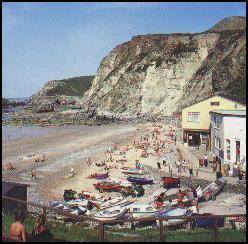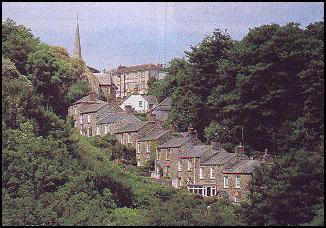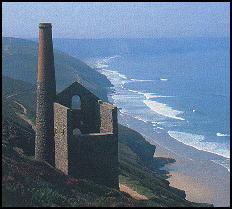


Historical village which tumbles down to the sea
Web: www.visitstagnes.com
Web: www.visitcornwall.com/destinations/st-agnes
Web: www.nationaltrust.org.uk/visit/cornwall/st-agnes-head
The very essence of the Poldark novels, the images, feelings and history they draw upon are to be found here at St. Agnes. The village is often described as a friendly retreat. Its people have a strong sense of history and a great love of home; perhaps it is this pervading warmth that affects those who stay here.
The village is about five miles north of Redruth and ten miles south-west of Newquay. The population at the 2011 census was 7,595. The village which is a popular coastal tourist spot, lies on the B3285.
The visitor to St. Agnes cannot fail to be impressed by St. Agnes Beacon, now owned by the National Trust, St. Agnes derives its old Cornish name Bryanick (pointed or prominent hill) from this dominant landmark, its 629 feet appearing all the greater because of its isolation in the landscape
Trevaunance Cove is a sandy cove popular with bathers and surfers. Plenty of facilities but parking is limited. Access to Trevaunance Cove beach is via the road. There is also a small beach to the north called Trevellas Porth. Both beaches have lifeguards in attendance during the season. The Genki beach cafe is close to the cove as is The Driftwood Spars pub.

With the lee of the hill for a pillow and with it's feet in the sea, St. Agnes lies comfortably in the heather like an old country giant. Founded on tin mining, but now a coastal resort, its dual character is reflected in its history and fine vernacular architecture. Miner's cottages and mine owners houses, the sea Captain's cottages of 'Stippy Stappy', picturesque engine houses and mine buildings, the lost harbours of Trevaunance Cove and the old market standings of Churchtown, all evoke times when values and fortunes were different.
The church, dedicated to St. Agnes, is on the main street in the village and was rebuilt in 1848.
Historically, St. Agnes and the surrounding area relied on fishing, farming and mining for copper and tin. At their height about 100 mines employed 1000 miners. In 1802, a pilchard fishing industry was established from the harbour, reaching its peak in 1829 and 1830 before declining.
Saint Agnes is the patron saint of young girls; folk custom called for them to practice rituals on Saint Agnes' Eve (20th - 21st January) with a view to discovering their future husbands.
John Passmore Edwards in 1893 had built and donated the Miners and Mechanics Institute in the village. Individuals could attend lectures or access the library. This one story building was designed by W.J. Willis and its exterior was made of killas and granite. The gabled roof was covered with Delabole slate. Within the building there were two main rooms and other smaller rooms.
From 1903 until 1963 a railway station on the Perranporth line operated in St. Agnes. After the railway station closed, the dismantled railway was used for the mining industry.
Between 1939 and 1940, Cameron Camp, also known as the 10th Light Anti-Aircraft Practice Camp, Royal Artillery, was built on the site of a Napoleonic Wars target. The camp was named after an area landowner and served as an army camp, slit trench and anti-aircraft battery. After the war the camp was used for housing. It was levelled in 1971.
Today's businesses, shops and hotels, fishing boats, village events and deep family ties, maintain continuity with the past.
The Blue Hills area hosts the Motor Cycling Club's Lands End Trial for cars and bikes. The first run being held in 1908.
On St. Agnes Head, one mile west of the village, is the National Coastwatch Institution lookout with amazing views up and down the coast.
Fans of Ross Poldark should know that Winston Graham lived just down the road and used the whole Parish as the inspiration for his Poldark series of books, dubbing it ‘Poldark Country’.
The Trevaunance Trail follows the rise and-fall of the Manor of Trevaunance and the Tonkin family.
From ancient times the Tonkin family monopolised the mining wealth of the area and when they saw that greater wealth could be achieved by opening up trade from Ireland and Wales they set about trying to construct a harbour at Trevaunance Cove. After three attempts a harbour was built in 1710 but the process had been costly over £6,000 had been spent on the harbour 'experiments' and the family were in debt. The estate was relinquished in 1719 and the unmaintained harbour was swept away into the sea in 1730. Sixty years later, a copper mining boom added new impetus to the quest for a harbour. The newly formed St. Agnes Harbour Company constructed the last of the St. Agnes harbours in 1798. The harbour enabled the development of pilchard fishery and general seaborne trade. The harbour stood for 118 years but again due to the lack of maintenance it was washed away in the storms of 1915.
Walks from 30 minutes to two hours are possible based in and around Trevaunance Cove. A leaflet highlighting these walks and points of interest on the way is available at many outlets in the area.
St. Agnes offers a variety of coastal, inland and valley walks, highlighting a huge range of interests from bird watching and wildlife to geology, folklore and industrial archaeology. The Coastal Footpath in this area offers amazing views down as far as St. Ives.
A particularly popular local walk through the Jerichco Valley runs inland from Trevellas Porth. Parking in Trevellas Coombe is limited although a new parking area at Wheal Kitty provides an alternative to the steep, descent into Trevellas Coombe. From the car park a circular walk following the stream up to the footbridge will then allow the walker to ascend out of the valley to the B3285, turning right along the grass verge and immediately right again into a farm lane known as Football Lane back to the car park.
The visitor to St. Agnes can not fail to be impressed by St. Agnes Beacon, a landmark now owned by the National Trust. St. Agnes derives its old Cornish name, Bryanick (pointed or prominent hill) from this dominant landmark. It's 629 feet appear all the greater because of it's isolation in the landscape. The view from the top of the Beacon offers a truly panoramic view of the cliffs from St. Ives in the south to Padstow in the North, and to Carn Brea, a few miles south.
A greater earthen bulwark believed to date from the Dark Ages. It originally ran from Chapel Porth to Trevaunance Cove. Legend has it that Bolster was a giant who fell in love with a young maiden called Agnes. As proof of his love Agnes demanded that the giant fill a small hole at the edge of the cliff with his blood. Being such a small hole the giant willingly did so. However, unbeknownst to him, the hole was bottomless and opened into a sea cave. Bolster continued to fill the cave until he was so weak that he fell into the sea and was no more (the blood stained cave may be found at Chapel Porth).
The St. Agnes Parish Museum offers an opportunity to study in more detail the landscape and the history of St. Agnes. The Museum is run entirely by volunteers and is a registered charity established to promote the heritage of St. Agnes. The mining and seafaring history of St. Agnes are vividly explained in displays and on film. The natural history display includes a 700lb leatherback turtle. Free parking is available in the main car park in the centre of St. Agnes village.

One of the best known and most picturesque groups of cliff-top mine buildings in Cornwall, offering superb coastal views. The buildings are owned by the National Trust.
Discover skills of the tinner on the fascinating journey from rock to metal. Guided tours of the workings and a selection of gifts made from pure tin.
The landscape around St. Agnes is promoted and cared for by the St. Agnes to Newquay Countryside Management Service. The service strives to balance the differing needs of the many users of the countryside and focuses on building an understanding between all those who live, work and visit the area so that all are working towards a common goal of protection and appreciation of the environment.
The countryside officer runs a comprehensive series of events throughout the year and details are available from the Countryside Management Service (01637) 851889.
St. Agnes is one of seven stations operating a lifeboat funded by viewers of the BBC television programme Blue Peter. The inshore lifeboat crews have been honoured with seven awards for gallantry.
John Opie (1761-1887), a notable painter, was born at Trevellas, near St. Agnes.
Thomas Tonkin (1678–1742), Cornish landowner and historian was also born here.
Driftwood Spars Sausage & Ale Festival - end of April.
St. Agnes Bolster Festival - end of April.
St. Agnes Street Fayre - end of May.
The West of England Steam Rally - mid August.
Chacewater Perranporth Porthtowan Redruth St. Day The Coastal Footpath
Callestick Farm Churchtown Arts Images of Cornwall Trevaunance Cove Craft Workshops
Cornish Lifeboat Stations Blue Hill Tin Streams St. Agnes Parish Museum Glen Carne Nursery & Gardens